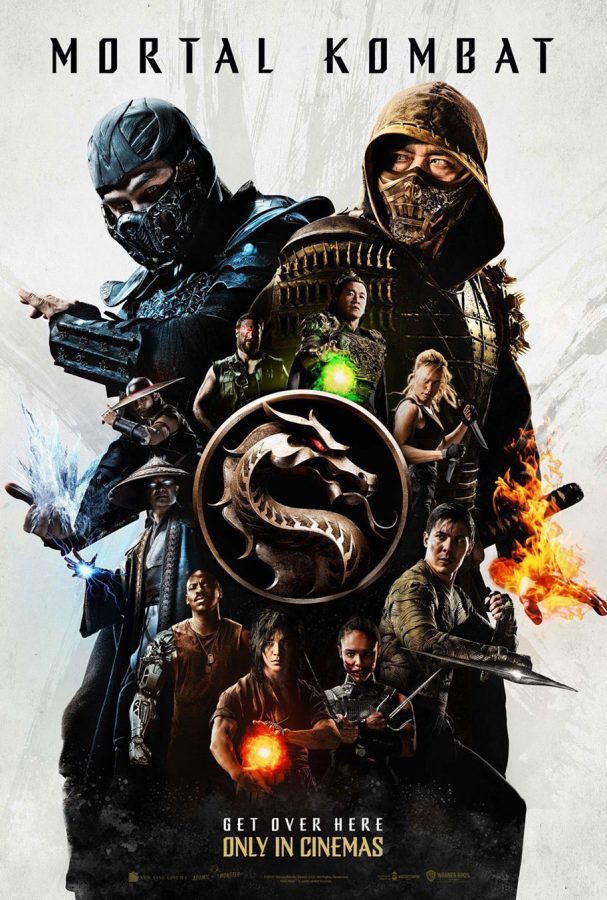“Mortal Kombat” (2021) reboot sets off on a rocky start
A never-ending cage match full of decapitations, gut punches, and gory kills makes the “Mortal Kombat” (2021) reboot, while problematic, worthy of its R-rating.
May 18, 2021
An upcoming MMA fighter is hunted down by Outworld’s fiercest fighter, Sub-Zero, to wipe out the competition before the universal fighting tournament begins. Surviving their encounter, Cole Young discovers that he’s been chosen to fight in this high-stakes competition between Earth realm and Outworld, home to the worst monsters imaginable. Cole, alongside a small group of fighters, must learn to come together to survive Outworld’s biggest threats lest they prove fatal.
“Mortal Kombat” (2021) is an action/fantasy film directed by Simon McQuoid based on the world-renowned video game franchise that spawned eighteen games, shows, and movies.
The first thirteen minutes of the movie are undeniably the strongest highlight of the entire film. In a quick and shockingly brutal sequence, viewers witness how the blood-fueled rivalry between Scorpion and Sub-Zero, two of the most iconic fighting game characters in history, came to be. The entirety of this opening feels as though it belongs in a completely different film as it’s set in the 17th century. Afterward, we’re immediately brought to the modern era which is a bit of a jarring tonal change.
With such a wide array of beloved characters, it’s understandable that some casting choices were questionable for some die-hard fans. Rest assured, this is one area the film truly succeeded in.
Hiroyuki Sanada as Hanzo Hasashi/Scorpion brings everything to the table and then some with his performance and fight sequences. Joe Taslim as Bi-Han/Sub-Zero is an absolute force of nature on-screen with his horror-like portrayal of the icy warrior. Scenes that feature Taslim’s character are visually impressive as well as dreadful whenever icy crystals begin to form near his next unsuspecting victim.
Josh Lawson completely stole the show with his perfect portrayal as Kano, a loveable wisecracking mercenary who kills without remorse. An all-around evil bad guy you can’t help but love Lawson’s portrayal as he carries a majority of scenes between the cast.
Fights are without a doubt, the main event of the “Mortal Kombat” universe. McQuoid clearly did his homework as it’s abundantly clear that the choreography and stunt work were a massive priority. Iconic moves like Kung Lao’s bicycle kicks and Scorpion’s kunai spear make this film feel like a love letter to fans.
The film earns its R-rating with its near 1:1 scale representation of the jaw-dropping fatalities that are infamous to the “Mortal Kombat” games. Iconic fatalities like arms being ripped out of their sockets, an opponent being sliced in two, and even one character being napalmed to death all find their way into the film.
Besides its near-perfect casting, characterization, and gruesome fatalities, there are a variety of questionable decisions that the film is plagued by. These issues range from studio interference to budgetary issues to problematic writing.
An example of the film’s budgetary issues comes from multiple fight scenes that are too quick with their resolutions. A majority of the film’s biggest fights all take place in a small training pit at Raiden’s (an Elder God tasked with protecting Earth) sanctuary, lending itself to confusing camerawork where characters often disappear and then reappear.
For a fighting-centered movie, one would believe that the soundtrack is filled with fast-paced thematic music. Instead, its soundtrack is terribly generic when compared to its original 1995 predecessor, which had the extremely memorable “Mortal Kombat” theme that fans know and love. Most of the themes are this soft-toned action-adventure theme that feels as though it belongs in an “Indiana Jones” movie rather than a film centered around killing your opponent to survive.
Perhaps the biggest fault of the film is its focus on Lewis Tan’s character Cole Young, a new addition to the “Mortal Kombat” universe. Cole himself isn’t an interesting character to root for and it was a highly questionable decision to make him the focal point of the reboot.
A majority of scenes are bogged down by unnecessary character exposition on Cole’s family. It becomes quickly apparent that Tan’s character is a self-inserted audience member who’s trying to catch up on the entire history of “Mortal Kombat.” Fans of the franchise will immediately recognize that this character was added to the film due to studio interference.
The worst grievance behind Cole Young’s entire character arc is that moviegoers are falsely led to believe throughout the entirety of the film’s runtime that he’ll become Scorpion, Sub-Zero’s archrival, due to his heritage. In reality, there’s no payoff for this entire arc. This brand new character, who was seemingly created to help audiences better comprehend the lore behind the fatal franchise, could be removed entirely from the movie for the better.
However, all of these issues can be expectantly forgiven when the film’s climactic showdown finally occurs. Seeing Scorpion face off against his icey archrival for round two makes all of the film’s annoyances well worth the price of admission.
With its few highs and bigger lows, “Mortal Kombat” (2021), is the little reboot that could. With promising hopes of a future sequel on the horizon after a successful release, hopefully with a bigger budget in mind, as well as better writing, this franchise comes back rejuvenated for round two.
Daniel Pineiro is a staff writer for the University Press. For more information regarding this or other stories, email dpineiro2015@fau.edu or @Danny_x101 on Instagram.






